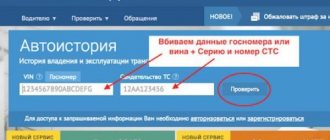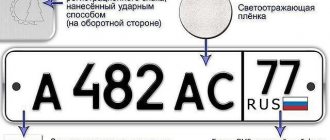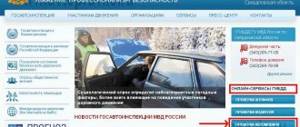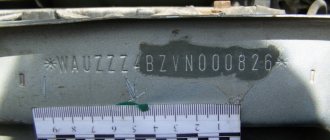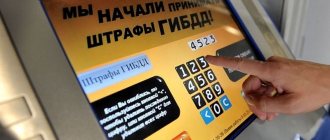What does it mean to seize a car?
For most inexperienced car owners, car seizure, ban or restriction of registration actions are identical concepts. However, from a legal point of view they are different.
The restriction prevents the implementation of ownership rights (or other rights) in relation to property. This measure can be used when dividing a car between spouses during a divorce, pledging a vehicle as collateral, etc.
A prohibition should be understood as a decision that prevents the owner of the property from performing a specific action or series of actions. For vehicles, a ban on registration actions is most often used. This measure can be used if there are debts on alimony, loans, fines and in other situations.
The concept of arrest is much broader than the previous ones. In accordance with Article 51 of the Federal Law “On Enforcement Proceedings” (FZ-229 of October 2, 2007), this measure provides for an inventory of property and a ban on performing absolutely any actions with it.
Also read: All about traffic police restrictions on cars
Checking a vehicle for recycling
This is a relatively new scam among car owners. They deregister the car, scrap it, and try to sell it at a very low price in the shortest possible time. Naturally, for the speed of the process, an attractively low price is set. The buyer can purchase such a car, but it will be impossible to register it after that.
It is possible to find out whether the vehicle was scrapped or not using the service. To do this, it is enough to enter the registration number of the car and get comprehensive information.
There is also the option of contacting the traffic police with a statement, but this procedure requires the personal presence of the car owner. You can also use the official website of the traffic police. In this case, you need to know the VIN of the car.
Who has the right to seize a car and in what cases?
This procedure can be initiated by a decision:
- court when satisfying the claim of any organization or government agency (bank, social security department, etc.);
- customs authorities;
- bailiffs.
There are many reasons why a car is seized. The most common of them are unpaid utilities, overdue loans, debts for alimony or traffic police fines. Also, punitive sanctions can be initiated for non-payment of taxes or for violations of customs clearance of a car (for example, the owner, in order to avoid paying a fee to the state treasury, imports it from abroad for spare parts, etc.).
Checking for fines
A future buyer always has the risk of purchasing a car with outstanding fines. Sellers themselves may often not be aware of the existence of debts to the traffic police. Sometimes information is concealed deliberately so that all debts are paid by the new owner of the car.
Of course, if the client receives this car, he cannot be forced to pay all the fines of the previous owner. But there are situations when registration restrictions are imposed on the car itself. Because of them, it will simply not be possible to register the car. To determine the presence of fines, you can use 2 services:
- "Autocode";
- official website of the traffic police.
To check a vehicle using the official website of the State Traffic Safety Inspectorate, you will need the number of the registration certificate and the vehicle itself. The service will provide the user with information only on the vehicle’s license plate number. In this case, the report will be more informative than from the official website of the traffic police. There is information about compulsory motor liability insurance, technical inspections, mileage, restrictions and additional information that may be useful to a future buyer.
Seizure procedure
The seizure of a car by bailiffs is carried out in the manner provided for in Articles 64 and 68 of the Federal Law “On Enforcement Proceedings”. FSSP employees are required to present the owner with the relevant resolution and draw up an inventory of the property.
An act of seizure must be drawn up and documents for the car must be confiscated: PTS and registration certificate (in this case, the presence of two witnesses is required). The act of seizure specifies the following parameters:
- car color;
- license plate;
- body and engine numbers (when it comes to trucks, the chassis number is additionally indicated).
In addition, the document must mention external and internal defects of the car.
Then the issue of transferring the vehicle for storage is decided. An outside person or organization with which the FSSP has concluded a corresponding agreement may be appointed responsible for the safety of the car. However, quite often the seizure procedure is not carried out. In this case, the owner of the car or one of his family members is appointed responsible for storage.
It should be remembered that using a seized car, in accordance with Art. 86 of the Federal Law “On Enforcement Proceedings”, it is impossible without the written consent of the bailiff. Otherwise, the matter may lead to criminal liability.
By the way, you most likely will not receive permission from the bailiff, since cars belong to the category of property that can suffer significant damage during operation (for example, in a traffic accident). Accordingly, the cost of the seized transport will decrease.
The lien on the car will be removed after the debt is paid off. Otherwise, it may be put up for auction.
Checking a car for theft
If a client buys a car that is listed as stolen, he will then have to sue its previous owner, because it will be impossible to register it after that. Moreover, 85% of such situations are resolved in favor of the former owner, who receives the car back. In this case, the buyer will lose not only the car, but also the funds that were invested in its purchase. Naturally, it is unlikely that you will be able to get your money back from a fraudster who sold a stolen car.
You can use several methods to check, including:
- official website of the traffic police;
- deregistering the car together with the seller, because if the car is stolen, then it will be impossible to do this.
It is also possible to use the service and get very detailed information in just 5 minutes along with other data.
In what cases can the seizure of a car by bailiffs be challenged?
According to current legislation, the arrest procedure cannot be carried out if the car belongs to:
- one of the debtor’s family members (for example, the husband’s car should not be seized for the wife’s debts or vice versa);
- a disabled person, and he needs it for movement;
- a debtor whose work is directly related to the use of a car he owns (taxi, freight transportation, etc.).
If the owner of the vehicle fits one of the above categories, but the arrest was still made, it’s time to go to court.
Checking for restrictions
You need to beware of purchasing a car that has been subject to restrictions. Restrictions on cars may be imposed in the following cases:
- if the customs authorities have doubts that the vehicle was cleared through customs legally;
- if the vehicle is being held in court as the subject of a dispute;
- if the owner of the car must pay the bailiffs a certain amount of money.
Vehicle restrictions can be easily checked using the official website of the traffic police. To do this, you will need information about the chassis number or VIN code.
The official website of the bailiffs also has information about whether there are restrictions on the car. To do this, you will need more information: TIN, SNILS, as well as the owner’s passport details.
The third option is the Autocode service, which will make it possible to obtain information in a faster way and with only a state number.
What are the risks of buying a seized car?
Some owners, after a car has already been seized, try to get rid of it. And there are buyers for such vehicles: they are attracted by the relatively low cost. If you make such a transaction knowingly, remember that you will not be able to legally complete the purchase. All seized vehicles are included in the traffic police database.
Often, the buyer simply does not know that the car sold to him is under arrest. Having contacted the traffic police, the newly-minted owner is denied registration of the vehicle. That is, you seem to have a car, but he cannot use it legally.
In this situation, there are several options:
- Try to get punitive sanctions lifted. True, this is only possible in a situation where the seizure occurred later than the conclusion of the purchase and sale agreement for the vehicle.
- Try to negotiate peacefully with the seller to terminate the transaction and return the money by sending him a corresponding claim in writing. The effectiveness of such actions is very doubtful, since the owner of the car perfectly understood the illegality of his act, which means that persuasion most likely will not work on him. Often the seller simply hides, turns off the phone and does not want to get in touch.
- If the second option does not work, you will have to file a claim to terminate the transaction and return the funds. The buyer has every right to do this in accordance with Article 460 of the Civil Code of the Russian Federation. Here you need to remember the following: if the transaction amount is less than 50 thousand rubles. - you should contact the magistrates, if more - the district court.
Practice shows that in the vast majority of cases your claim will be satisfied, but be prepared for the fact that the legal proceedings will take about 2 months.
An important point when drawing up a purchase and sale agreement (SPA) is to indicate the actual cost of the car. Often, by mutual agreement, a much smaller amount is fixed on paper. At the same time, the buyer should understand that if, for example, he actually paid 500 thousand rubles for the purchase, and the contract indicates half that amount, it will be very difficult to return the money in full. After all, the court does not need words, but documented evidence.
Checking whether the car is listed as collateral
If a car owner takes out a loan secured by a vehicle, then such a car is collateral. If the client did not receive this information before the purchase, the bank may oblige the new owner of the collateral to pay the loan for the previous owner or even seize such property.
However, you should not immediately refuse such an acquisition if you discover information that this is collateral. Sometimes banks and credit organizations themselves sell collateral at a very attractive price after it has been seized from the owners.
To check whether a car is collateral, you can use two options:
- service "Autocode";
- register of the notary chamber.
To verify through the notary chamber registry, you will need to use information about the pledgor, the vehicle VIN, and the registration number. To obtain information through a special service, a VIN code or vehicle registration number will be sufficient.
A word from the experts
Yulia Kombarova, General Director of Legal Bureau No. 1:
“In all standard contracts for the purchase and sale of property, including cars, there is a clause that states: “The seller guarantees that the car is not pledged, that third parties have no claims to it, and the seller also guarantees that it has no signs of and bankruptcy cases filed.” This clause of the contract protects the buyer, and places full responsibility for the circumstances of the transaction on the seller. Therefore, in the event of detection of arrests imposed on the item of purchase, after concluding a sales contract and transferring money, the buyer has the right to invalidate the contract, receive the money back and return the car.
Proving the good faith of the acquirer is, of course, a time-consuming legal process. But for the services of a representative and other legal expenses can be recovered from an unscrupulous seller in court. It should be noted that if you win a lawsuit, you will not be able to get money right away. Most likely, you will have to contact the bailiff service, and if the debtor is in bankruptcy proceedings, then submit your claims to the register of creditors of the debtor in the bankruptcy case.”
Valerik Vardanovich Galstyan, senior partner of the law firm:
“In such a situation, things can develop in two ways:
- If the contract for the sale and purchase of a vehicle was executed before the seizure, then the new owner has the opportunity to try to lift the seizure in court by proving that he was a bona fide purchaser, and at the time of the seizure the vehicle was not owned by the seller.
- If the purchase and sale agreement was executed after the seizure, the car will be confiscated from the new owner, since the seizure is a restriction on taking actions to alienate property. Therefore, the seller did not have the right to sell the property under arrest.
In the second case, the new owner has every right to terminate the purchase and sale agreement concluded with the seller and demand the return of the funds paid by him.”
Checking for car involvement in an accident
More than 75% of cars that are sold have been in an accident at least once in their history. Sellers often try to hide this fact and thus ensure that they increase the amount for which they can sell the car.
It is possible to visually notice signs of repair, even with the high quality of work of specialists. It is possible to notice different headlights, traces of paint on joints and seals, as well as other visual defects that the manufacturer does not allow during the production of the car. If there are noticeable signs of repair, then you should definitely check the car with the help of a special service. From the report, the client will receive detailed information about what accidents the car has been in during its operation.
Documentation check
Before buying a used car, it is important to check the documentation:
- PTS;
- vehicle registration certificate;
- seller's passport.
Make sure that there are no special stickers or marks on the PTS. What's the catch here? Marks are placed in cases where the body or engine numbers are interrupted, unreadable or unreadable.
Be wary if the seller provides you with a duplicate title. A duplicate PTS is issued if the original was lost or damaged, and also if there are no free lines left to enter the owners of the car. Therefore, you need to check with the seller how many owners the car had and for what reason the duplicate was made.
Also read: What the PTS will tell you: how buyers of used cars are deceived
But don’t rush to refuse to buy a car just because it’s a duplicate. Check your car using the Autocode service. If the verification data does not contradict the seller’s words, then there is nothing to fear. If the service reports that the vehicle had two or more owners, and the seller claims that he is the first and last owner, then it is better to refuse the transaction.
Be sure to check the data from the seller’s passport with the data specified in the PTS. Even small differences in documents may subsequently lead to you not being able to register the car.
Test Drive
A test drive is an integral part of checking the technical condition of a car. If the seller of a used car insists that he does not have time to drive around the city, then it is better to refuse the purchase. Most likely, serious shortcomings that appear while driving are being hidden from you.
Before the test drive, ask the seller what investments will be needed after purchase. Most often, under the guise of minor flaws, quite large problems are hidden that will require a lot of money. Carefully remember all the faults that the seller mentions. They will have to pay more attention during the test drive.
Also read: How to Test Drive a Used Car
While driving, go at both low and higher speeds. Check for any unusual noises or knocks. For example, if the steering wheel vibrates when driving, this may subsequently lead to replacing the box. And such a procedure costs at least 30,000 rubles.
For what debts is information provided?
Information can be obtained on any debt. The exception is situations related to a ban on the disclosure of personal or government data. For example, if the case concerns personal information or the reputation of the plaintiff or defendant. In such cases, some details will be viewable only by participants in the process. Situations of this type are rare. Restrictions are imposed, as a rule, on the basis of requests from lawyers.
Attention! The completeness of the information provided may depend on the resource used. Extended information can be obtained on the FSSP website. The Gosuslugi portal provides only general data without any specifics.
When is it necessary to search for enforcement proceedings?
After a court decision is made, the plaintiff has the opportunity to obtain a writ of execution. This is a document that gives him the right to forcibly collect obligations from the defendant. Some debtors, until a certain moment, do not know about the existence of their debt and about the decision made by the court, and accordingly do not know how and where to view the writ of execution from the bailiffs on the FSSP website.
The need to find an individual entrepreneur arises in the following cases:
- Violation by the court of the deadlines for notifying the defendant about the existence of a debt that arose as a result of the verdict.
- The defendant lacks registration (permanent and temporary), as a result of which the executors are not able to serve him with a notice.
Citizens have the right to check themselves or their company for debt at any time at their discretion. It is recommended to carry out additional checks in the following cases:
- When planning a trip abroad. Due to debt, citizens may be limited in traveling abroad.
- In case of violation of payment terms. In this case, the payer is subject to a penalty in the amount of 5% of the debt amount, but not less than 500 rubles.
- To eliminate the possibility of debt, which is necessary in order to protect against the risk of bailiffs taking measures to forcibly collect obligations, for example, confiscation of property or seizure of bank accounts.
Ways to check the writ of execution and enforcement proceedings
There are several methods for testing IL and production:
- obtaining information from the FSSP department;
- obtaining information using special Internet services.
Do I have a writ of execution - how can I find out from the bailiffs?
On the executors’ resource, you can find information about the availability of a writ of execution by creating a request using the data available to the user:
- by the last name of the debtor or by the name of the legal entity (depending on the status of the debtor);
- by production number;
- by the number of the executive document.
Attention! All of the above data are interconnected in the FSSP database. Having information on one of them, you can get acquainted with information on the others.
How to find out the debt under a writ of execution to bailiffs
You can get acquainted with data on the presence of debt on individual entrepreneurs online using the following methods:
- using the database on the FSSP website;
- on the portal "State Services";
- on the website "Justice";
- on the portal of the magistrate or arbitration court.
To get information about the existence of enforcement proceedings via the Internet, the user does not have to be a debtor, while to obtain information offline, you need to come to the FSSP office with a passport to confirm your identity.
Information that can be found from the writ of execution
In the bailiffs database you can find the following information:
- Defendant's details: full name, date and place of birth (for individuals) or name, legal and actual address (for legal entities).
- Information about the individual entrepreneur: number, date of initiation.
- Details of the writ of execution: type, date of preparation, number, name of the court that issued it.
- Date, reason for the end or termination of the individual entrepreneur, indicating the article, part, point of the basis.
- Service
- Subject of execution, amount of outstanding debt.
- Details of the bailiff department: name and address.
- Data of the bailiff.
How to view a writ of execution by number
To view the writ of execution by number, you need to:
- Go to the data search service on the FSSP website using the link: https://fssp.gov.ru/iss/ip.
- Select the search method “Search by ID number”.
- Select the territorial body of the FSSP.
- Enter the number of the executive document.
- Select the type of executive document.
- Enter the name of the court that issued the writ of execution.
- Click the “Find” button.
Dear readers ! To solve exactly your problem, contact our online consultant on the website. It's free. For any region.
Dear readers ! To solve exactly your problem, contact our online consultant on the website. It's free. For any region.
Information about the specified IL will appear on the screen, indicating its number:
How to find a writ of execution by last name
To find an IL by the defendant’s last name, you need to:
- Go to the search service on the FSSP website using the link: https://fssp.gov.ru/iss/ip.
- Select the search method “Search for individuals.”
- Select the territorial body of the FSSP.
- Enter the last name, first name and patronymic of the citizen.
- Indicate your date of birth.
- Click the “Find” button.
Information about the presence or absence of outstanding obligations of the specified individual will appear on the screen:
